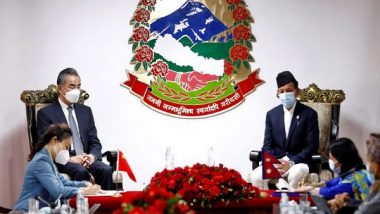Kathmandu [Nepal], December 24 (ANI): Satoru Nagao, a fellow (non-resident) at Hudson Institute in Tokyo, whose primary research area in US-Japan-India security cooperation, has advised Nepal to gradually distance itself from China.
In an interview with The Annapurna Express (ApEx), he said, "China's infrastructure projects and economic support could be a 'debt trap'. Japan's one is workable and far better. America is on the road to winning the competition with China. The winning side is always beneficial. But when Nepal shows a clear stance against China, China will provoke and try to punish Nepal. Therefore, Nepal should gradually distance itself from China. For Nepal to cooperate with the QUAD (comprising of Australia, Japan, India and US) side more deeply and steadily is the best policy."
Also Read | COVID-19 Outbreak in China: Country Estimates Coronavirus Surge Infecting 37 Million People A Day.
His views were in reference to Nepal's conduct of foreign policy in the turbulent geopolitical environment.
On Japan's new National Security Strategy and its implications for the Indo-pacific region, he said its impact would spread to the Indo-Pacific region.
"Firstly, Japan clearly identifies China, North Korea, and Russia as threats to Japan in this document. Secondly, Japan will integrate strategies both military and non-military to deal with the threats. And thirdly, Japan will strengthen international cooperation to deal with China, which means like Australia and India, Japan will possess counter-strike capabilities. In some cases, Japan will commit an offensive-defence operation," said Satoru.
The offence-defence combination with long-range strike capability is a more effective strategy than a defence-only strategy to counter China's territorial expansion.
According to him, if Japan and India possess long-range strike capabilities, the combined capability would make China defend multiple fronts. Even if China decides to expand its territories along the India-China border, China still needs to expend a certain amount of its budget and military force to defend itself against Japan, he said.
"Japan will increase official development assistance (ODA) for a strategic purpose. For the purpose of deepening security cooperation with like-minded countries, apart from ODA for the economic and social development of developing countries and other purposes, a new cooperation framework for the benefit of armed forces and other related organizations will be established," said Satoru.
It will affect the whole part of the Indo-Pacific. For a long time, a 'hub and spoke' system has maintained order in the Indo-Pacific. In this system, the hub is the US and the many spokes are its allies such as Japan, Australia, Taiwan, the Philippines, Thailand, and South Korea in the Indo-Pacific.
However, China's recent provocations indicate that the current system has not worked to dissuade its expansion. Between 2011 and 2020, China increased its military expenditure by 76 per cent while the US decreased its spend by 10 per cent, reported ApEx.
Many bilateral, trilateral, quadrilateral or other multilateral cooperation arrangements--such as US-Japan-India, Japan-India-Australia, Australia-UK-US(AUKUS), India-Australia-Indonesia, India-Australia-France, and India-Israel-UAE-US(I2U2)--are creating a network of security cooperation and sharing the regional security burden.
Talking about Japan's South Asia policy, its priorities, and its interest in this region, he said, "Japan supported many infrastructure projects in South Asia purely because Japan tried to contribute to the local society. However, since China expanded its influence in South Asia and provoked Japan in many places in the Indo-Pacific, Japan's attitude has changed. Because China's infrastructure projects are the ones with a high-interest rate, it created huge debt and Sri Lanka needed to give China the right to control Hambantota port. This is one typical example of how dangerous China's hegemonic ambition has become. This time, the National Security Strategy of Japan clearly wrote "Strategic Use of ODA." Japan will continue many infrastructure projects in South Asia as pure assistance. But at the same time, Japan will increase the projects to save local countries and dissuade China's hegemonic ambition."
He also highlighted the growing rivalry between the US and China in the Indo-Pacific region, adding that US National Security Strategy indicated that US-China competition will escalate. The document states, "The PRC is the only competitor with both the intent to reshape the international order and, increasingly, the economic, diplomatic, military, and technological power to do it. And three factors indicate that America is on the road to winning the competition with China."
The US is still stronger than China. A SIPRI database indicates that the US military expenditure in 2020 was three times bigger than China's. In addition, the US has more allies. The number of political partners has been a decisive factor in geopolitical competition, reported ApEx.
Moreover, if the US National Security Strategy states that 'the PRC is the only competitor', it is natural to conclude that the US has a plan to defeat China, said Satoru.
US Republicans and Democrats share many similar goals toward China. The Trump administration's so-called 'high-tech war,' which banned products from Huawei and ZTE, started when the Investigative Report on the US National Security Issues Posed by Chinese Telecommunications Companies Huawei and ZTE was published in 2012, during the Obama administration. The current Biden administration also continued the policy.
Speaking about India's stand on the US-China rivalry, Satoru said India and Japan share the same set of problems.
"In the sea around the Senkaku Islands of Japan, China has employed its coast guards and increased its activities. A comparison between the number of Chinese vessels identified within the contiguous zone in the waters surrounding the Senkaku Islands in Japan and China's incursions in the Sino-Indian border area are similar," said Satoru.
These incursions are similar to China's activities around the Senkaku Islands of Japan. Based on the number of Chinese incursions in the India-China border area and Chinese activities in the sea around the Senkaku Islands, it becomes apparent that China has increased its assertiveness in 2012 and 2019 in both regions, reported ApEx.
Satoru underscored that India should cooperate with the US, Australia and Japan. (ANI)
(This is an unedited and auto-generated story from Syndicated News feed, LatestLY Staff may not have modified or edited the content body)













 Quickly
Quickly
















